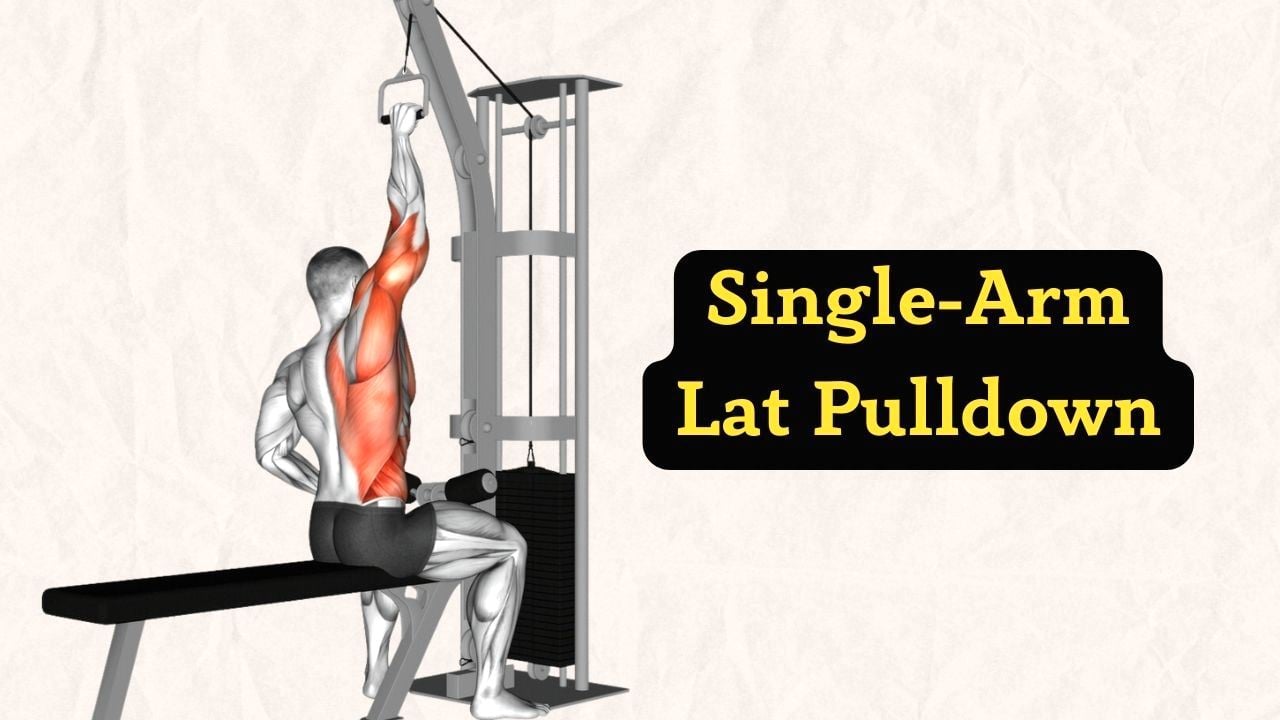If you have one lat that’s stronger or more developed than the other, single-arm lat pulldowns can help even things out.
It is a unilateral variation of the classic lat pulldown that targets your lats and allows you to focus on each side individually. The unilateral movement increases the range of motion and allows for increased lat concentration.
Since you are resisting rotation and keeping balance while doing it, your core muscles have to work harder to keep your body stable.
You Can do one arm lat pulldown with different grips (pronated, supinated, neutral) to target the back muscles from various angles and incorporate more muscle fibers.

Single-Arm Lat Pulldown Muscles Worked
The Single Arm Lat Pulldown primarily targets the upper back muscles, specifically the latissimus dorsi. However, the exercise also engages various other secondary and stabilizing muscles to some extent.
- Primary muscle: Latissimus dorsi (lats)
- Secondary muscles: Biceps, rear deltoids, trapezius, Rhomboids Brachialis and Brachioradialis
- Stabilizing muscles: Core (abdominals, obliques), rotator cuff muscles, forearm flexors, serratus anterior, lower back muscles.
How To Do One Arm Lat Pulldown
- Attach a D-handle (the one shaped like a D) or wide grip bar.
- Sit down and adjust the pad so your thighs are secure underneath it.
- Grab the handle with one hand, using a supinated grip (palm facing away).
- Lean back slightly from your torso (think 10-15 degrees) and keep your shoulders down and away from your ears.
- Inhale and initiate the pull using your lats. Imagine pulling your elbows down and back towards your pockets, not just bending your arms.
- Pull the handle down until it reaches your upper chest (think just above your pecs).
- Hold the contraction for a second at the bottom of the movement, really squeezing your lats.
- Then exhale and slowly release the weight back up to the starting position.
- Repeat for those hard-earned reps, then switch arms and show the other side some love.
Tips and Form
- Maintain a tall spine with a slight backward lean (around 10-15 degrees). Avoid arching your back or rounding your shoulders.
- Want to really hit those lats from all angles? Try experimenting with neutral and an underhand grip on some sets.
- Proper form is everything here, so keep that spine neutral and avoid any excessive arching or leaning.
- Pull down and in until you feel a strong contraction in your back. Make sure your elbows are in line with your body and not behind it.
- Don’t twist the body. Brace your body in such a way that the only real movement is in your working lats and scapula.
- Avoid slouching in the finished position to maintain a “proud chest” and proper muscle activation.
- Don’t forget to breathe, folks. Exhale on that pulling motion, inhale as you extend back to the start.
- For variation and to hit the muscles from a slightly different angle, change your grip and positions. Personally, I would also recommend sitting on the floor or squatting position to do it.
- Start with a light weight, work on that control. Sets of around 12-15 with nice control.
Variations and Modifications of the Single Arm Lat Pulldown
1. kneeling Single Arm Lat Pulldown
The kneeling position requires a lot of core work to keep a stable torso. Compared to a seated or standing lat pulldown, this recruits the abdominal and lower back muscles to a greater degree.
However, if you choose the kneeling variation, I would get a bench or a plyobox to brace the non-working arm with.
2. Single-Arm Resistance Band Lat Pulldown
Attach a resistance band to a high anchor point and perform the single-arm lat pulldown motion. This variation adds an element of instability, engaging more stabilizing muscles.
3. Single-Arm Lat Pulldown (Neutral Grip)
When compared to a supinated grip, where the palms are facing upwards, the neutral grip minimizes bicep involvement and allows one to concentrate solely on the lats.
The neutral grip is a comfortable position for your wrists, and it may be helpful to you if you have wrist issues or find supinated grips uncomfortable.
4. Single Arm Pause Pulldown
Adding a pause at the bottom of the movement can exhaust muscle fibers and enhance muscle activation. Holding the bottom position for a few seconds before releasing the weight challenges the muscles further.

Manish is a NASM-certified fitness and nutrition coach with over 10 years of experience in weight lifting and fat loss fitness coaching. He specializes in gym-based training and has a lot of knowledge about exercise, lifting technique, biomechanics, and more.
Through “Fit Life Regime,” he generously shares the insights he’s gained over a decade in the field. His goal is to equip others with the knowledge to start their own fitness journey.
